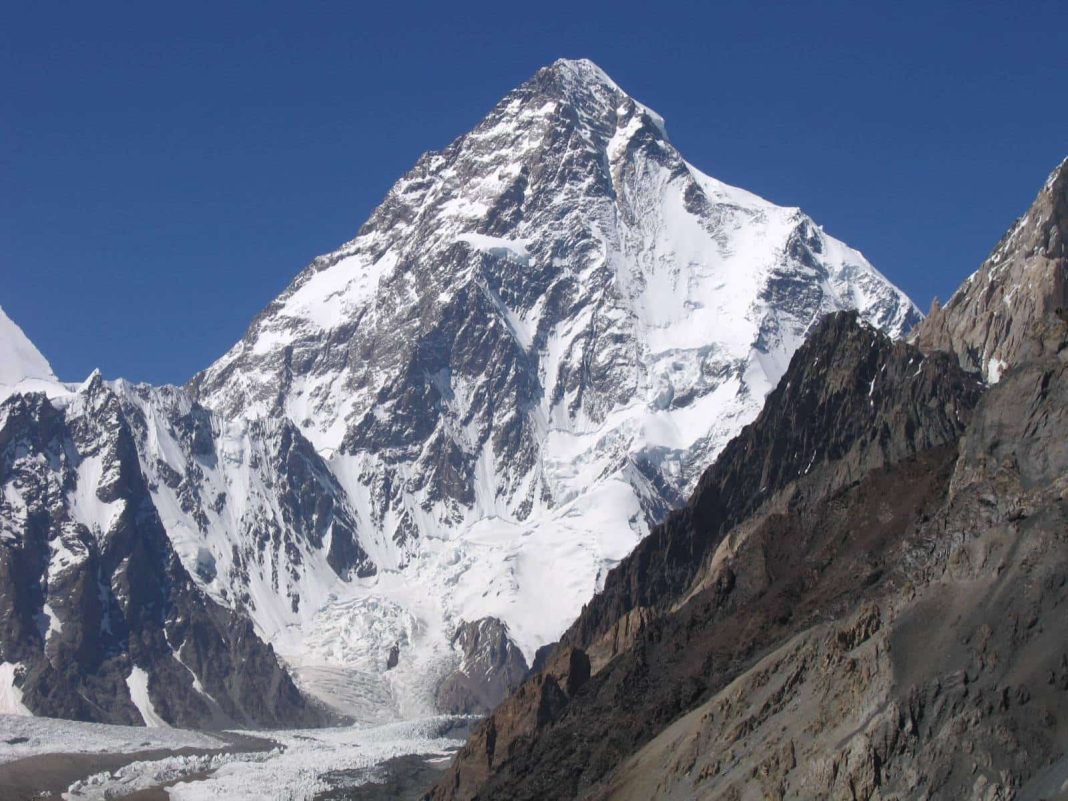K2 is the second highest mountain peak in the world after Mount Everest. Its elevation is 8,611 meters (28,251 ft) above sea level. This peak belongs to the Karakoram range of the Himalayas and is located on the borders of Gilgit-Baltistan in Azad Kashmir and Taxkorgan in Jingjian, China.
K2 is also known as Wild Mountain as it is extremely difficult to climb. After Annapurna, K2 ranks second in death rate among eight-thousander peaks. One in four climbers die at its summit.
Early campaigns in K2
The first attempt to climb K2 was made by an Anglo-Swiss expedition in 1902, and they managed to climb to an altitude of 18,600 feet (5,670 m) along the northeast flank of the peak. Among other unsuccessful attempts was an Italian expedition in 1909 led by Luigi Amedeo, Duke of Abruzzi, along the southeastern flank of the ridge (later known as the Abruzzi Ridge) and they managed to climb to a height of about 20,000 feet (6,100 m). Then in 1938, an American expedition led by Charles Houston managed to climb the Aburajee Ridge to a height of about 26,000 feet (7,925 m). Finally, In 1954, an Italian expedition team led by geologist Ardito Desio conquered K2 of the Aburazzi Ridge Barabar. Achille Compagnoni and Lino Lacedelli reached the highest point on July 31, 1954 at 6 pm local time. Now it is not possible to climb K2 in winter.
Nomenclature of K2
The name K2 derives from the notation used by the Great Trigonometrical Survey of British India. Thomas Montgomery first surveyed the Karakoram from Mount Haramukh, about 130 ma (210 km) to the south, and mapped two prominent peaks labeled K1 and K2, where K stands for Karakoram.
The principle of large trigonometric surveys was to use local names of hills where possible and K1 is known locally as Masherbram. However, K2 is thought not to have acquired the local name, perhaps due to its remoteness. The mountain is not visible from Askol, the last village in the south, or from the nearest settlement in the north, and is only glimpsed from the end of the Baltoro Glacier, beyond which few locals venture. The name Chogori has been suggested as a local name deriving from the two Balti words གོོ་གྷའོ་ (“big”) and རརི’ (“mountain”) (चुगूरी)[9][10] but there is little evidence of its widespread use. It could be a compound name invented by Western explorers or “what’s that called?” There may be a surprising answer to the question. But it forms the basis of Kogi’s name (Simplified Chinese: 乔戈里峰; Traditional Chinese: 喬戈里峰; Finn: Qiáogēlǐ Fēng) by which Chinese authorities officially refer to the peak. Other local names including Lamba Pahar (“high mountain” in Urdu) and Dapsang have been suggested, but are not widely used.
As the mountain had no local name, the name Godwin-Austen Mountain was proposed in honor of Henry Godwin-Austen, an early explorer of the area. Although the name was rejected by the Royal Geographical Society, it was used on several maps and continues to be used occasionally.
The surveyor’s mark K2, therefore, remains the name by which the mountain is commonly known. It is also now used in the Balti language, rendered as Kechu or Ketu (Balti: ک کو Urdu: ک تو). Italian mountaineer Fosco Maraini, in his account of the ascent of Gasherbroom 4, argued that while K2’s name may be attributed to accidental origin, its rugged, impersonal nature is too remote and too well-suited to challenge a mountain. He concludes what was, “… but a mere name-filling, all rock and ice and storm and underworld. It makes no attempt to sound human. It is atoms and stars. It has the opening of the earth before the first man—or of the planet after the end.”
Andre Weil named the surface K3 in mathematics partly because of the beauty of the K2 mountain.
Geographical layout of K2
K2 is located in the northwestern Karakoram Mountains. It is located in the Gilgit-Baltistan region of Pakistan and the Taxkorgan Tajik Autonomous County of Xinjiang, China.[b] The Tarim Alluvial Basin borders the Lesser Himalayas to the north and south. Meltwater from glaciers such as the southern and eastern valleys of K2 contributes significantly to agriculture and the regional freshwater supply.
K2 is ranked 22nd in terms of spatial prominence, a measure of a mountain’s individual height. It is part of the same extended area of elevation as Mount Everest (including the Karakoram, the Tibetan Plateau and the Himalayas) and it is possible to follow a route from K2 to Everest at Mustang Low at Kora La on the Nepal/China border at 4,594 m (15,072 f) not less than Other peaks much lower than K2 are more distinctive in this sense. But it is the most prominent peak in the Karakoram range.
K2 is notable for its projection from the local surface as well as its total height. It rests on the lower reaches of the glacial valley above 3,000 meters (9,840 ft). It is a consistently steep pyramid, descending rapidly in almost all directions. The northern side is the steepest: there it rises only 3,200 meters (10,500 ft) above the K2 (Kogi) glacier in a horizontal distance of only 3,000 meters (9,800 ft). In most directions, it achieves 2,800 meters (9,200 ft) of vertical relief in less than 4,000 meters (13,000 ft).
A 1986 expedition led by George Wallerstein made a measurement error that showed K2 was taller than Mount Everest and therefore the highest mountain in the world. A revised measurement was made in 1987, but by then the claim that K2 was the tallest mountain in the world had already become the subject of many news reports and references.



 For all latest articles, follow on Google News
For all latest articles, follow on Google News